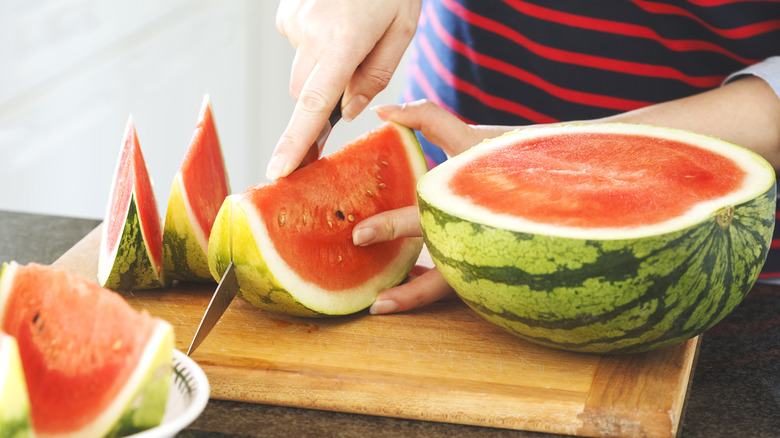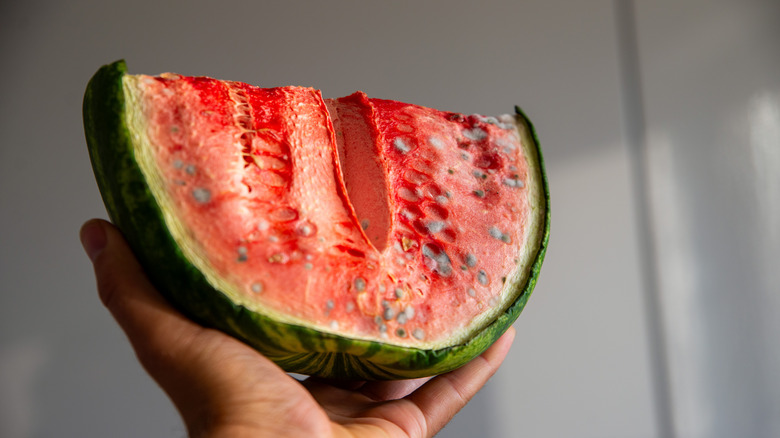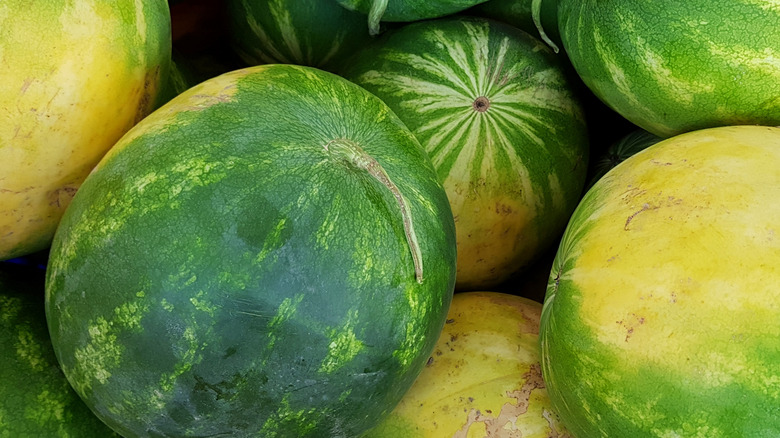Here's What A Bad Watermelon Looks Like Inside
When picking out most produce at the grocery store, we rely on our senses, often looking over our options, maybe giving the fruit a sniff or a gentle squeeze. But when choosing a watermelon, a bit of luck is involved. Even if you select your fruit with a well-trained eye — looking for all the right clues that your melon will be juicy, delicious, and ripe — you never know exactly what you'll find on the inside until you slice it open,
Once you bring your pick home, though, you need to know the telltale signs to keep an eye out for, based on the fruit's flesh, to know when it's time to toss. Should you slice through the tough outer rind to find unpleasantries like funky smells, slimy feeling flesh, or, of course — the most glaring sign your melon has turned — any spots of mold, you've got a bad apple — er, melon.
Despite your best efforts to pick out the best watermelon from the grocery store (like choosing symmetrical, heavy melons and giving it a good thump), there's always the occasional dud in the batch. Or, if you've kept your melon in the kitchen for too long, it may have passed its prime. As with most foods, toss it if you can't be sure. But barring any obvious signs, knowing when your watermelon has expired isn't always as clear-cut as you might think.
Use all your senses to tell when watermelon is bad
Even with many shelf-stable foods, best-by and expiration dates are often more of a guideline than a hard and fast rule. And with fresh produce, it's even harder to pinpoint the exact date by which it will go bad. In these cases, a little common sense and relying on your eyes, nose, and sense of touch will be key for differentiating the good from the rotten.
Generally, a fresh watermelon will be good for around five days after it's sliced when kept in the fridge. Watermelon, with its super thick, tough rind, seems almost invincible, but you should still employ safe prep and good storage tips. Always wash the outside before slicing through it, for example, and keep cut watermelon cold. A whole, uncut fruit will be good after you purchase it for around a week, should you wait that long to delve into it.
While some less-than-ideal textures and cosmetic flaws don't necessarily spell danger for your melon (more on that in a second), others are non-negotiable red flags, like weird, sour tastes or icky smells. Dates aside, if in doubt, toss it. Sidenote — if you split open a watermelon you just brought home from the store and find any of these signs, you can still return it to the store, which should refund you so you can try again for a better pick!
There's a difference between imperfect and rotten watermelons
Summer and cool slices of watermelon are all basically synonymous — the juicy, sweet refreshing fruit is a must. So it's extra heartbreaking when you get a bad one. Plus, we all want to do our best to reduce food waste, and it hurts any foodie's soul to unnecessarily toss food. So while you should keep an eye out for signs that your watermelon is destined for the compost, don't be too hasty.
Some traits you might think mean a melon is bad, are false alarms — like an imperfect rind. Some exterior dry, brown, webbing, or big yellow blotches (a sign of a good fruit, actually!) are all perfectly normal. So long as the inside is good, dig in!
And while not ideal, mealy fruit texture is not a dealbreaker either. This almost frothy dryness means fruit may be a bit overripe, but it's quite a common occurrence, and a mealy melon is safe to eat. Just because and older fruit may not hit the spot quite like a perfectly smooth, juicy, crisp one, don't toss it out. Even a mealy watermelon still makes a mean frozen margarita, or you can always freeze it for later use in smoothies. Just keep a close eye out for mealy (safe) devolving into slimy territory (time to toss!)


